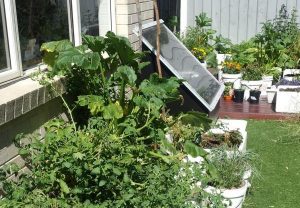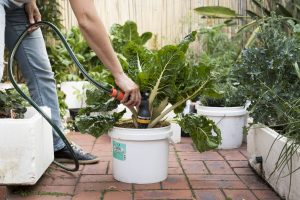Menu image: Amy Piesse Photography
| Smart renter | Save up to $1000 a year* |
|---|---|
| Very smart renter | Save up to $3000 a year or more* |
*Estimated savings for a smart renter assume that the garden supplies all herbs, tea herbs, greens and certain high yielding vegetables over a space of up to 10m2 yielding 10-20% of your produce. For a very smart renter, we’ll assume that the garden supplies almost all of the household produce. Conditions vary so this is a rough estimate.
Growing your own food in the age of cheap and subsidised food from the supermarket may seem quaint yet there are so many good reasons to do it. You can still save a decent amount of money, become more food self-sufficient, have a beautiful garden, pick up some valuable skills and end up with far healthier and tastier food.
Growing your own food might not have the same wow factor as a solar array or wind farm, yet we think that there is nothing more beautiful than a food producing garden and the importance of taking control of our food production can’t be understated. And as you’ll see below, renters can do this too.
Until recently in human history, only kings and queens (or other rulers and their extended families) made no effort to grow food. With the invention of fossil fuel based fertilisers and herbicides, world food production exploded leading to the neglect of soil fertility and the impacts of pest resistance to herbicides.

Now we have a problem
- The world will need to produce 56% extra food to feed 10 billion people in 2050 on the same amount of land [1].
- One third of the world’s soil has been depleted leaving just 60 years of farming left if we continue business as usual [2].
- We cannot rely on an increasing supply of fossil fuels for fertiliser as new oil discoveries have declined significantly in the last 30 years [3].
- At the extreme end, some foods require 100 times the energy in fossil fuel to produce and transport one calorie of food energy [4].
- Pesticides in some cases are no longer effective against crop pests due to increased resistance, while they maintain their harmful effects on the environment and people exposed to them [5].
- In Australia, food production is a big user of water [6].
- 16% of food grown in Australia will be thrown out before it reaches the customer [7].
- Food production is a major source of global emissions, exceeding those contributed by the transport sector [8].
- For all the fuss that corporate agricultural companies like to make about feeding the world, smallholders with less than 2 hectares grow an estimated 20-50% of the world’s food while farms of 50 hectares or less grow 60-90% [9].

You might think that the tomatoes for $3 a kilo at the supermarket are a bargain until you realise they contribute to food waste, plummeting biodiversity, deforestation, topsoil loss, climate change and depleted fossil fuel reserves.
Home grown food on the other hand…
- Tastes better and is more nutritious when grown in good soil and minimal to no pesticides are used.
- Attracts beneficial birds and insects to the garden and is cost effective compared to buying conventional and organic produce [10].
- Creates an attractive garden.
- Is more convenient than going to the supermarket.
- Is a no regrets solution for our environment.
- Helps insulate you against price shocks or the loss of income.
- Excess produce can be preserved or traded for other home grown foods (e.g. eggs or fruit).
- Is really enjoyable when you get to know where your food comes from.
- Dramatically lowers food waste as you probably won’t throw out a slightly wonky cucumber like the supermarkets would.
- Lowers food production water consumption by using water smart ideas like portable wicking beds.
- Costs can be kept really low by growing your own seedlings and using green waste for a portable composting system.
- Setting up and running a garden doesn’t take up too much of your time if you design it well (We average 2 hours a week throughout the year and we still have room to improve).
Ok, you’ve convinced me, where should I start?

- Herbs, tea herbs and salad greens are a no brainer and are great for gardening in small spaces as they are expensive to buy for their weight and spoil quickly in transit.
- Vegetables and small space fruits are the next step, starting with high yielding varieties like zucchinis, cucumbers, tomatoes, strawberries and the like.
- If you have more than 100m2 of space, fruit and nut trees start to make sense as does integrating animals like chooks into your garden.
- If you are new to growing food, start with a realistic amount of space to help find your feet rather than taking on far too much in the beginning (e.g. In the first year, aim for herbs and salad greens, then step up to vegetables, then fruit, etc.).
How much of my own food can I realistically grow?
- The average American eats 907kg of food a year, a figure that the average Australian wouldn’t be far from [11].
- It’s unlikely that you’ll grow this much food in a backyard, especially if you need to include rice, wheat, dairy or significant amounts of meat in your diet, though a keen grower could get close on the right block of land [12].
- Whether or not you could grow all of your food is beyond the point, even growing and foraging a portion of it will give you some food security.
- As an example, two renters in Lilydale on Melbourne’s eastern fringe grew 329kg of produce in 70m2 of garden beds over the spring and summer in one season which would be an impressive 18% of their total food by weight if they ate like an average American for the year [13].
- We estimate that a smart renter who grows their own food can save between $500 to $3000 a year or more depending on how much of their needs they can meet [14].
- Obviously time is a limitation, though a household in Northcote grew 428kg of their food in a single year averaging half a day of work a week in the garden [14].
Learning to grow your own food is one of the most sustainable actions you can take and can provide you with a significant amount of tasty home grown food all year round. See Gardening in small spaces for ideas on how to grow a lot of food in wicking beds that you can move with you.
Further Reading:
[1] https://www.wri.org/blog/2018/12/how-sustainably-feed-10-billion-people-2050-21-charts [2] https://www.scientificamerican.com/article/only-60-years-of-farming-left-if-soil-degradation-continues/[3] Trying to predict when world oil reserves will dry up is beyond our mental capabilities though the fact that new discoveries are not keeping pace with consumption suggests that that day will not be too far away:
https://www.visualcapitalist.com/map-worlds-biggest-oil-discoveries-since-1868/
[4] https://www.resilience.org/stories/2005-04-01/why-our-food-so-dependent-oil/ [5] http://sitn.hms.harvard.edu/flash/2015/gmos-and-pesticides/ [6] https://www.abs.gov.au/ausstats/abs@.nsf/mf/4618.0 [7] https://www.wri.org/blog/2018/12/how-sustainably-feed-10-billion-people-2050-21-charts [8] https://www.epa.gov/ghgemissions/global-greenhouse-gas-emissions-data[9] The reason that we have given a range is that there are different results across different studies so this at least gives you some idea:
https://www.sciencedirect.com/science/article/pii/S2211912417301293
[10] This survey found that even conventional produce is marked up for 50-70% at the point of retail: [11] https://www.reference.com/world-view/many-pounds-food-average-adult-eat-day-3f49d34cd3d872cd [12] https://retrosuburbia.com/case-studies/saba-and-matts-rental-property-case-study/ [13] http://urbanhomestead.org/about/by-the-numbers/[14] The rental property mentioned above grew $2000 worth of produce (from our calculations) if it had to be replaced with conventional produce though this would roughly double in price if we compared it with organic produce. A household with a small backyard in Northcote grew 428kg of food in a single year and would exceed the $3000 estimate that we have provided, showing how far you can go:
https://retrosuburbia.com/case-studies/the-plummery-case-study/